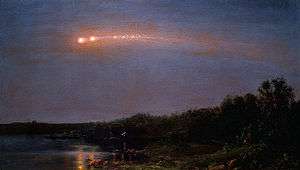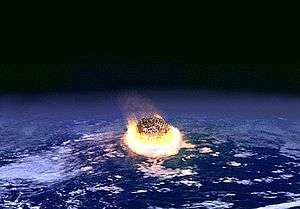Meteor procession

Oil painting by Frederic Church, The Meteor of 1860
A meteor procession occurs when an Earth-grazing meteor breaks apart, and the fragments travel across the sky in the same path. According to physicist Donald Olson, only a few occurrences are known, including:[1]
- Great Meteor of August 18, 1783[1][2]
- Meteor procession of July 20, 1860; believed by Donald Olson to be the event referred to in Walt Whitman's poem Year of Meteors, 1859-60.[3][4]
- Meteor procession of December 21, 1876; sighted over Kansas, Missouri, Illinois, Indiana, Ohio, Pennsylvania.[5]
- Meteor procession of February 9, 1913; a chain of slow, large meteors moving from northwest to southeast, sighted over North America, particularly in Canada, the North Atlantic and the Tropical South Atlantic.
See also
References
- 1 2 Falk, Dan. Forensic astronomer solves Walt Whitman mystery, NewScientist, June 1, 2010
- ↑ Notes and Queries, Journal of the Royal Astronomical Society of Canada, Vol. 8, p.221-2
- ↑ Images of Harper's Weekly front page story
- ↑ 150-year-old meteor mystery solved
- ↑ Report of the annual meeting British Association for the Advancement of Science 1877 pages 149-153.
External links
This article is issued from Wikipedia - version of the 8/20/2016. The text is available under the Creative Commons Attribution/Share Alike but additional terms may apply for the media files.

